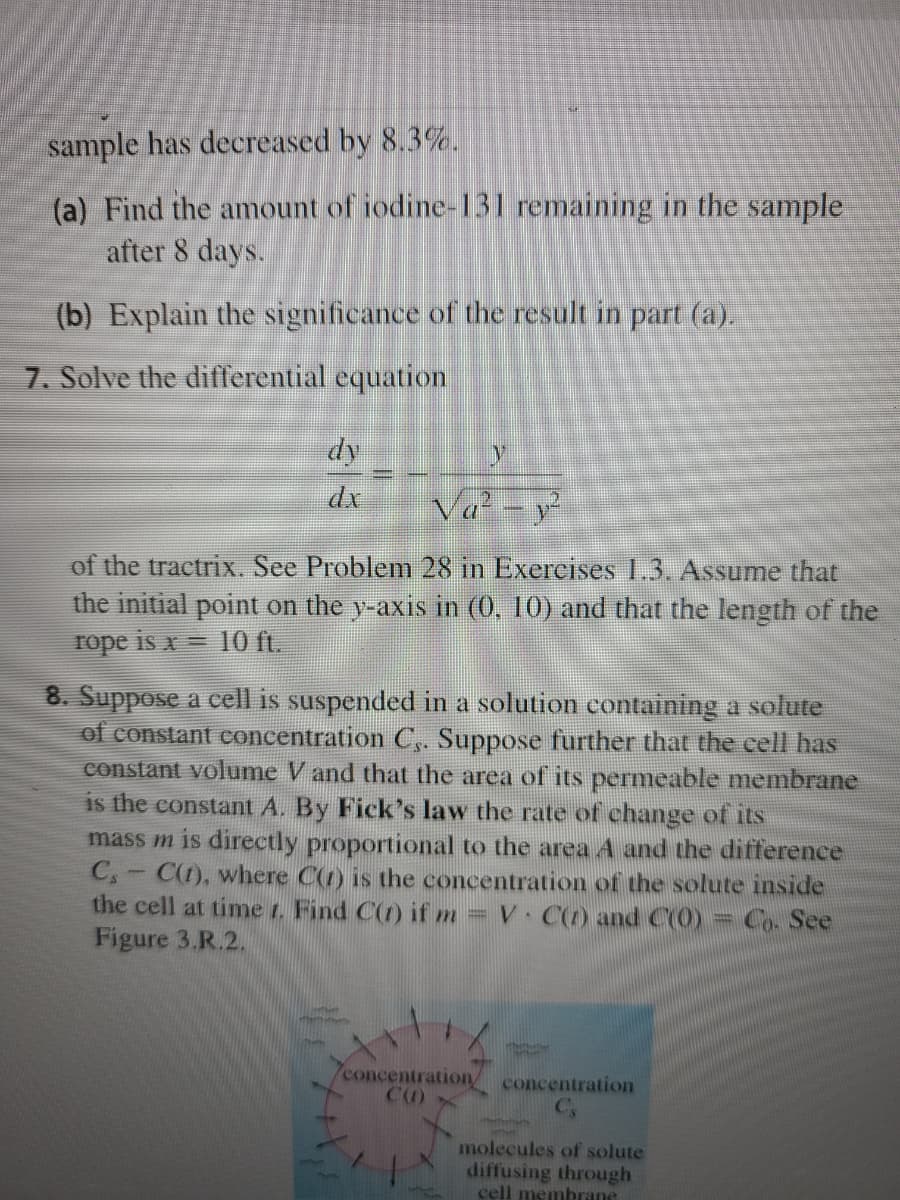Calculus: Early Transcendentals
8th Edition
ISBN:9781285741550
Author:James Stewart
Publisher:James Stewart
Chapter1: Functions And Models
Section: Chapter Questions
Problem 1RCC: (a) What is a function? What are its domain and range? (b) What is the graph of a function? (c) How...
Related questions
Question
Need help with #7

Transcribed Image Text:sample has decreased by 8.3%.
(a) Find the amount of iodine-131 remaining in the sample
after 8 days.
(b) Explain the significance of the result in part (a).
7. Solve the differential equation
dy
dx
Va - y
of the tractrix. See Problem 28 in Exercises 1.3. Assume that
the initial point on the y-axis in (0, 10) and that the length of the
rope is x = 10 ft.
8. Suppose a cell is suspended in a solution containing a solute
of constant concentration C,. Suppose further that the cell has
constant volume V and that the area of its permeable membrane
is the constant A. By Fick's law the rate of change of its
mass m is directly proportional to the area A and the difference
C,
C(1), where C(1) is the concentration of the solute inside
the cell at time r. Find C(t) if m = V C(1) and C(0)
Figure 3.R.2.
Co. See
concentration,
concentration
molecules of solute
diffusing through
cell membrane
Expert Solution
This question has been solved!
Explore an expertly crafted, step-by-step solution for a thorough understanding of key concepts.
This is a popular solution!
Trending now
This is a popular solution!
Step by step
Solved in 2 steps with 2 images

Recommended textbooks for you

Calculus: Early Transcendentals
Calculus
ISBN:
9781285741550
Author:
James Stewart
Publisher:
Cengage Learning

Thomas' Calculus (14th Edition)
Calculus
ISBN:
9780134438986
Author:
Joel R. Hass, Christopher E. Heil, Maurice D. Weir
Publisher:
PEARSON

Calculus: Early Transcendentals (3rd Edition)
Calculus
ISBN:
9780134763644
Author:
William L. Briggs, Lyle Cochran, Bernard Gillett, Eric Schulz
Publisher:
PEARSON

Calculus: Early Transcendentals
Calculus
ISBN:
9781285741550
Author:
James Stewart
Publisher:
Cengage Learning

Thomas' Calculus (14th Edition)
Calculus
ISBN:
9780134438986
Author:
Joel R. Hass, Christopher E. Heil, Maurice D. Weir
Publisher:
PEARSON

Calculus: Early Transcendentals (3rd Edition)
Calculus
ISBN:
9780134763644
Author:
William L. Briggs, Lyle Cochran, Bernard Gillett, Eric Schulz
Publisher:
PEARSON

Calculus: Early Transcendentals
Calculus
ISBN:
9781319050740
Author:
Jon Rogawski, Colin Adams, Robert Franzosa
Publisher:
W. H. Freeman


Calculus: Early Transcendental Functions
Calculus
ISBN:
9781337552516
Author:
Ron Larson, Bruce H. Edwards
Publisher:
Cengage Learning